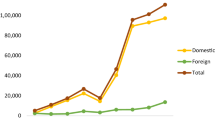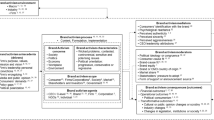Abstract
This study discusses places that choose to turn their negative past occurrences and characteristics into opportunities. The goal of the research was to find which campaign components and marketing initiatives were used by places that elected to use the ‘turning a place’s liability into an asset’ strategy. The findings show that there are two main categories of situations in which marketers tend to use this strategy, both of which contain various sub-categories. The two categories are: (i) situations in which negative past occurrences and events are used as tourism attractions; (ii) situations in which problematic place characteristics that usually hinder tourism are turned into assets to attract a specific target audience. The research used qualitative content analysis of advertisements and news reports.
Similar content being viewed by others
References
Avraham, E. and Ketter, E. (2008) Media Strategies for Marketing Places in Crises: Improving the Image of Cities, Countries and Tourist Destinations. Oxford: Butterworth Heinemann.
Avraham, E. and Daugherty, D. (2009) ‘We’re known for oil. But we also have watercolors, acrylics and pastels’: Media strategies for marketing small cities and towns in Texas. Cities 26 (6): 331–338.
Avraham, E. and Ketter, E. (2013) Marketing destinations with prolonged negative images: Towards a new model. Tourism Geographies 15 (1): 145–164.
Avraham, E. (2013) Battling stereotypes of terror and wars: Media strategies for marketing tourism to Middle Eastern countries. American Behavioral Scientist 57 (9): 1350–1367.
Baker, B. (2007) Destination Branding for Small Cities. Portland, OH: Creative Leap Books.
Baker, V. (2011) In Pablo Escobar’s footsteps. The Guardian 13 September.
Beirman, D. (2002) Marketing of tourism destinations during a prolonged crisis: Israel and Middle East. Journal of Vacation Marketing 8 (2): 67–176.
Beirman, D. (2003) Restoring Tourism Destinations in Crisis. Cambridge, UK: CABI.
Belize Tourism board. (2010) Belize mother nature’s best keep secret. National Geographic Traveler. 7-8/2010, p. 7.
Benoit, W.L. (1997) Image repair discourse and crisis communication. Public Relations Review 23 (2): 177–187.
Curacao Tourism Board. (2009) Curacao – The hidden treasure of the Caribbean. Budget Travel. 7-8/2009, p. 66.
Canfield, B.R. and Moore, H.F. (1973) Public Relations: Principles, Cases and Problems. Homewood. IL: Richard D. Irwin.
Clark, A. (2010) Banking crisis? Walk this way. The Guardian 28 May.
Coombs, W.T. (1999) Ongoing Crisis Communication: Planning, Managing and Responding. California: Sage.
Cyprus tourism organization. (2010) ‘A great world in one small island’ campaign, http://www.netravel.co.il, accessed 3 November.
Daytona Beach Area convention and Visitors Bureau. (2010) Special advertising section for Florida tourism. Budget Travel. 9/2010.
de Jager, A.E. (2010) How dull is Dullstroom? Exploring the tourism destination image of Dullstroom. Tourism Geographies 12 (3): 349–370.
Eritrea Ministry of Tourism. (2011) Welcome to Eritrea, Africa’s hidden gem, http://www.youtube.com/watch?v=VjvgcvkD600, accessed 29 May.
eTurboNews (eTN). (Various dates) http://www.eturbonews.com.
Finland Tourism Board. (2006) Lapland – Vitality from nature, http://www.laplandfinland.com, accessed 29 October.
First, A. and Avraham, E. (2009) America in JeruSALEm: Globalization, National Identity, and Israeli Advertising. Lanham, MD: Lexington Books.
Gertner, D. and Kotler, P. (2004) How can a place correct a negative image? Place Branding and Public Diplomacy 1 (1): 50–57.
Goffman, E. (1963) Stigma: Note on the Management of Spoiled Identity. Englewood Cliffs, NJ: Prentice Hall.
Glaesser, D. (2006) Crisis Management in the Tourism Industry. Burlington, MA: Butterworth-Heinemann.
Gold, J.R. and Ward, S.V. (eds.) (1994) Place Promotion: The Use of Publicity and Marketing to Sell Towns and Regions. Chichester, UK: John Wiley & Sons.
Govers, R. and Go, F. (2009) Place Branding. London: Palgrave Macmillan.
Greater Boston Convention and Visitor Bureau. (2010) Boston, great deals$. summer steal$. National Geographic Traveler. 7-8/2010, p. 59.
Hawaii Tourism Authority. (2010) Hana, http://www.gohawaii.com/maui, accessed 19 October.
Ireland Tourism Board. (2010) Ireland, island of 100 000 welcomes. National Geographic Traveler. 7-8/2010.
Kavaratzis, M. and Ashworth, G. (2008) Place marketing: How did we get there and where are we going? Journal of Place Management and Development 1 (2): 150–155.
Kirschenbaum, E. (2011) Germany rebuilds part of Berlin wall. Routers. (Translated in Ha’artez, 10 August 2011).
Kotler, P., Haider, D.H. and Rein, I. (1993) Marketing Places. New York: Free Press.
King, R.T. (2005) Harbin snow and ice festival, http://www.rtoddking.com/chinawin2003_hb_if.htm, 13 October.
Lahav, T., Mansfeld, Y. and Avraham, E. (2013) Public relations for rural areas. Journal of Tourism and Travel Marketing 30 (4): 291–307.
Lennon, J. and Foley, M. (1999) Interpretation of the unimaginable: The US Holocaust Memorial Museum, Washington, D.C, and dark tourism. Journal of Travel Research 38 (1): 46–50.
Long, J. (2009) Sustaining creativity in the creative archetype: The case of Austin, Texas. Cities 26 (4): 210–219.
Myers, L.S. (2005) Night in the Gulag. Ha’aretz, 12 June.
Mansfeld, Y. and Pizam, A. (2006) (eds.) Tourism and Security: A Case Approach. London: Butterworth Heinemann, pp. 233–249.
Missouri Division of Tourism. (2010) Don’t take less of a vacation. National Geographic Travel. 9/2010, p. 45.
Medway, D., Warnaby, G. and Dharni, S. (2011) Demarketing places: Rationales and strategies. Journal of Marketing Management 27 (1–2): 124–142.
Meisenbach, R. (2010) Stigma management communication: A theory and agenda for applied research on how individuals manage moments of stigmatized identity. Journal of Applied Communication Research 38 (3): 268–292.
Morgan, N. and Pritchard, A. (2001) Advertising in Tourism & Leisure. Woburn: Butterworth-Heinemann.
Montana Office of Tourism. (2010) There’s nothing here campaign. National Geographic Travel. 1-2/2010, p. 15.
Muzaini, H., Teo, P. and Yeoh, S.A. (2007) Intimations of postmodernity in Dark Tourism: The fate of history at Fort Siloso, Singapore. Journal of Tourism and Culture Change 5 (1): 28–45.
Nielsen, C. (2001) Tourism and the Media. Melbourne: Hospitality press.
Official Tourism and Travel Guide of Bratislava. (2010) ‘Bratislava, Europe’s hidden treasure’, http://www.bratislava.sk, accessed 19 October.
Pike, S. (2004) Destination Positioning Slogans – Analysis of Themes used by New Zealand Regional Tourism Organizations. In: Proceedings of the Australian and New Zealand Marketing Academy Conference, 29 November–1 December, New Zealand: Victoria University.
Ritchie, B.W. (2009) Crisis and Disaster Management for Tourism. Bristol, UK: Channel view publications.
Seaton, A.V. (1999) War and thanatourism: Waterloo 1815–1914. Annals of Tourism Research. 26 (1): 130–158.
Sharpley, R. and Stone, P.R. (2009) The Darker Side of Travel: The Theory and Practice of Dark Tourism. Bristol, UK: Channel view publication.
Shields, R. (1992) Places on the Margin. London: Routledge.
Sierra Leone Travel and Tourism. (2011) Sierra Leone – Tourism, http://www.youtube.com/watch?v=r-CWFTJBXSc, accessed 29 March.
Strange, C. and Kempa, M. (2003) Shades of dark tourism: Alcatraz and Robben island. Annals of Tourism Research 30 (2): 386–405.
Tourism Review. (Various dates) http://www.tourism-review.com.
Tilson, D.J. and Stacks, D.W. (1997) ‘To know us is to love us’: The public relations campaign to sell a business-tourist-friendly Miami. Public Relations Review 23 (2): 95–115.
Tuchman, G. (1991) Qualitative methods in the study of news. In: K.B. Jensen and N.W. Jankowski (eds.) A Handbook of Qualitative Methodologies for Mass Communication Research. London: Routledge.
Wight, A.C. (2006) Philosophical and mythological praxes in dark tourism: Controversy, contention and the evolving paradigm. Journal of Vacation Marketing 12 (2): 119–129.
Author information
Authors and Affiliations
Corresponding author
Rights and permissions
About this article
Cite this article
Avraham, E. Spinning liabilities into assets in place marketing: Toward a new typology. Place Brand Public Dipl 10, 174–185 (2014). https://doi.org/10.1057/pb.2014.21
Received:
Revised:
Published:
Issue Date:
DOI: https://doi.org/10.1057/pb.2014.21




